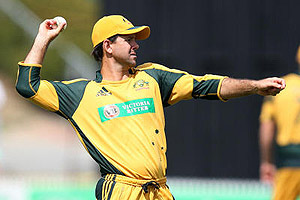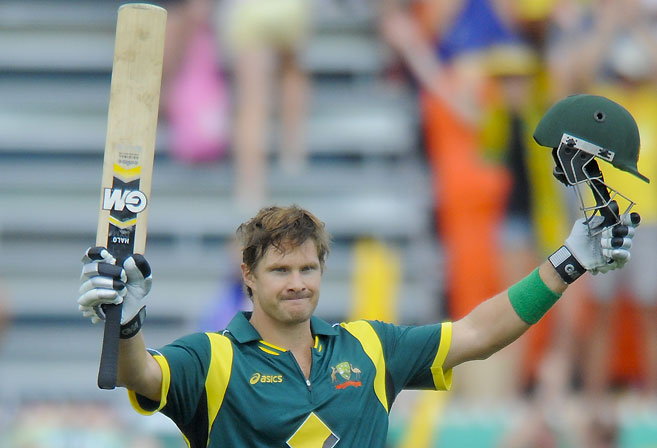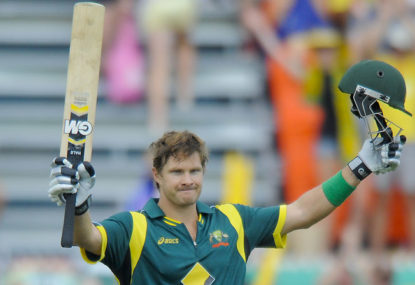Australia has been blessed with outstanding ODI cricketers over the past twenty years.
World Cup wins in 1999, 2003, 2007 and 2015 demonstrate this.
As such, I have made my selection of our best ODI team of the past twenty years.
There were a number of positions in the side which required much consideration and others which were no brainers.
Either way, this is a formidable line-up.
1. Adam Gilchrist (wk)
While his average of 35.89 doesn’t hit the heights of his rivals for an opener’s spot, Gilchrist made up for it with the rate that he scored his runs.
A strike rate of 96.94 was almost unheard of in the mostly pre T20 era in which Gilchrist donned the green and gold.
He was a master of putting opponents on the back foot from ball one, often unleashing his vicious cut and pulls shots off the first ball of the innings.
472 dismissals and almost ten thousand ODI runs make Gilchrist a lock for the wicket keeping position.
2. David Warner
It could be argued that having two similar players at the top is undesirable, but I disagree.
Warner is more than capable of playing a patient role at the top in ODIs.
And an opening combination of himself and Gilchrist would strike fear into many opposition bowling attacks.
An average of 43.12 and strike rate of 95.46 illustrates how dangerous an ODI player Warner is. Warner’s 11 ODI hundreds in just 88 matches help him earn his place ahead of his nearest rival Matthew Hayden.
Hayden possessed very similar career stats to Warner but his record of ten hundreds from 161 ODIs is far inferior to Warner, and hundreds are like gold to top order players.
3. Ricky Ponting (c)
The perfect number three, Ponting was capable of both continuing an onslaught and consolidating after an early wicket.

Ponting is the most prolific ODI batsman in Australia’s history, scoring 13,704 runs at an average of 42.03, striking at 80.39 and notching 30 hundreds. With an unbeaten 140 in a World Cup final, he was certainly a man for the big stage.
There is no competition for this spot in the order.
Ponting also gets the captaincy, having led Australia to numerous World Cup successes.
4. Michael Bevan
Bevan was a crucial member of Australia’s ODI team for a decade and was regularly considered the best ODI batsman in the world during his career.
The left-hander read ODI run chases better than most, regularly getting Australia home in tight situations.
He was a model of consistency with almost seven thousand runs at 53.58 in ODIs. His strike rate of 74.16 in the pre T20 era more than passable.
Bevan often batted at six or seven in the Australian ODI line-up, but there is value in batting him higher, given the superior hitting abilities of those to come in this XI.
5. Michael Hussey
Hussey was Australia’s T20-era Michael Bevan. He regularly played a similarly crucial role at six or seven in the Australian order, often rescuing a collapse or bulking up the total with lusty hitting at the end of an innings.
Hussey’s defence was equally as good as his substantial attacking abilities, making him one of Australia’s most consistent ODI batsmen in history. His statistics are exceptional – over five thousand runs at 48.15 and a strike rate of 87.16. Another lock for this line-up.
6. Andrew Symonds
This was a tricky one. Surprisingly, Steve Waugh’s statistics in the ODI arena (average of 32.90) put him out of contention early.
I expected it to come down to Steve Smith and Michael Clarke in the end. Their stats are very similar, especially once you remove Smith’s early days batting at seven and eight. Both average around 45 with this taken into account.
Smith’s strike rate of 87.83 exceeds Clarke’s 78.98. Smith, generally batting at three, has seven hundreds in just 76 innings, whereas Clarke owns just eight in 223 innings. However, Clarke is the half century king, passing fifty on 58 occasions.
As you can see, the two are very hard to separate.
Then after Shane Watson pipped Symonds narrowly for the chief all-rounder role, I had to reconsider Symonds.
When batting in the top six, Symonds averaged 42.91, with a career strike rate of 92.44. Add to that his ability to chip in a few quick overs of off spin or medium pace (with 133 wickets at an average of 37.25), and his stellar fielding, and this created an almighty conundrum.
Since the vacant position is at six, I went with Symonds for his hitting ability, versatility, fielding and great ODI batting record.
7. Shane Watson
Watson pips Symonds for the main all-rounder role due to his superior bowling.
While Watson opened frequently for Australia in ODIs, his power hitting makes him a valuable player to have coming in late in the innings.

With almost six thousand ODI runs at 40.54, a strike rate of 90.44 and nine hundreds, Watson wouldn’t be far off making this team as a pure batsman.
Though he’s often underrated for his effectiveness as a bowler, he showed over his career he can have an impact, with 168 wickets at 31.79 and an economy rate of under five an over.
8. Shane Warne
Most would consider Warne a lock for this team, but he was challenged all the way by the ageless Brad Hogg.
In the end, Warne’s consistency and big match performances give him the nod. With 293 wickets at 25.73, an excellent economy rate of 4.25 and strike rate of a wicket every six overs, Warne is tough to match.
Though Hogg possesses similar stats, there is only one Shane Warne, and his performances in World Cups were crucial to Australia’s successes.
9. Brett Lee
Lee’s sheer speed and ability to swing the new ball made him lethal in ODI cricket. Though successful in Test cricket, the ODI arena is where he really shone.
A career that included 380 wickets at 23.36, a wicket every five overs and an economy rate under five, are all reasons for his selection in this team.
Lee was an asset, bowling both with the new ball and at the death, and provided an underrated intimidation factor to opposition batting line-ups.
10. Mitchell Starc
It’s not always ideal to select current players, but Starc well and truly deserves this spot. His pace, swing and deadly yorkers have made him the number one ODI bowler in the world, regardless of what the rankings say.
Starc picks up his wickets at the astonishing rate of once every four overs, averages a brilliant 19.66, and concedes less than five an over.
He almost single-handedly demolishes batting line-ups regularly and has a World Cup final win under his belt already.
11. Glenn McGrath
Arguably our greatest ever fast bowler, McGrath’s impeccable control and ability to move the ball off the deck ensured he was a mainstay in Australia’s Test and ODI sides for over a decade.
McGrath’s record is a testament to his vast abilities, with 381 wickets at 22.02 with an economy rate of 3.88.
Hard to score off and always a threat, McGrath’s position in this team was never in doubt.
Apologies to:
Steve Smith – give him another year or so and he’ll be a shoe in
Michael Clarke – very close, strike rate lets him down a touch
Matthew Hayden – close but not enough hundreds
Mark Waugh – just behind Gilchrist, Warner, and Hayden
Brad Hogg – just behind Warne
Jason Gillespie – victim of the quality of the pacers who made it
Nathan Bracken – see Gillespie
Ryan Harris – if only he could have played more matches
Agree? Disagree? That’s what selecting a dream team is all about!































































































